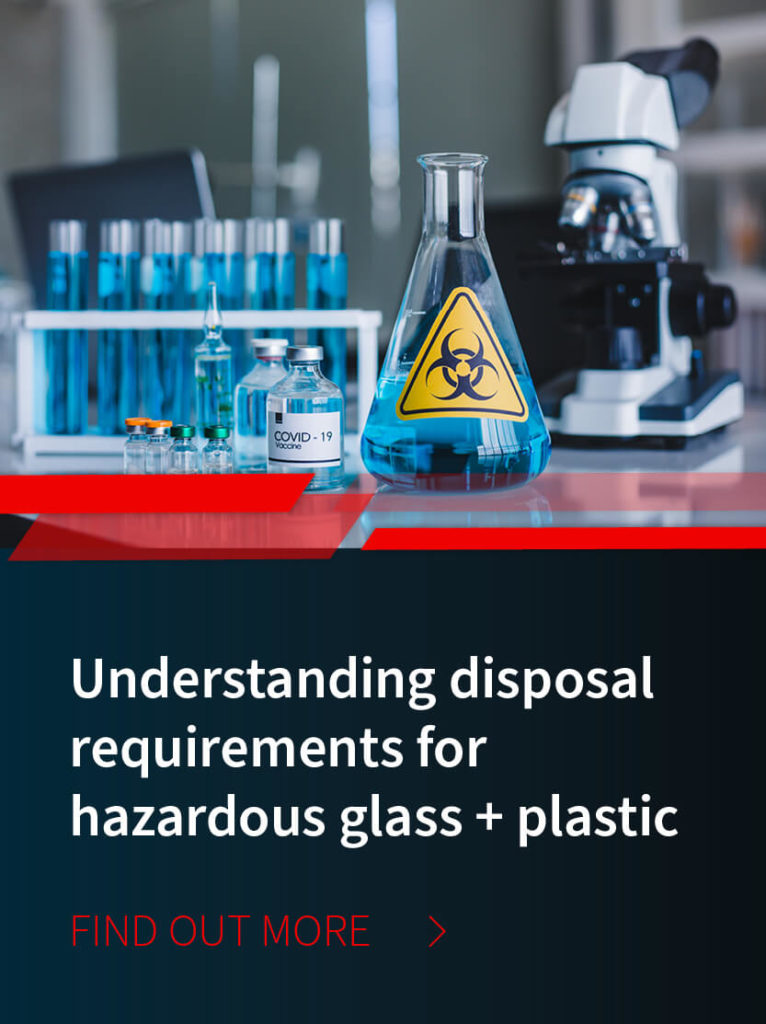
/ IN THIS BLOG
If you manage or work in a hospital, university, laboratory, or any manufacturing industry environment that uses small containers of chemicals and other potentially hazardous materials (thinners, solvents, paints, inks, etc.), it’s extremely important that you store, package, ship, and dispose of all that waste material properly. This is done with lab packs – but not necessarily limited to chemicals that comes strictly from a laboratory.
As such, a lab pack is something that you and your employees should be familiar with—whether you undertake the process yourself or hire out the service to a qualified waste management company.
01 / Important Details Regarding Lab Packs
What Is a Lab Pack, and What Does it Contain?
A lab pack is a type of container (such as a drum or box) that holds a number of smaller items such as bags, bottles, ampules, vials, jars, etc., of expired, damaged, partially used, mislabeled, contaminated, or out-of-date chemicals. The smaller chemical (and self-contained) items are placed in larger containers for proper shipping and disposal. Lab packs must be transported and disposed of properly – or risk criminal fines and penalties.
Before packing any chemical containers into the lab pack, a qualified individual must create an inventory of every expired, damaged, or out-of-date chemical to be disposed of. This inventory should accurately detail everything that’s going into the pack in order to properly – and safely - dispose of chemicals that are no longer needed.
To load the lab pack (drum), small vials and containers (anywhere from one-quarter ounce to gallon jugs) are packed together into the larger container which must be packed according to waste type, so the waste segregation process is vital.
For example, flammable items should be packed with other flammable items. Corrosive waste should be packed with similar corrosive waste. You should never mix flammable, corrosive, or reactive materials within one large container.
The size of that final large container varies according to the specifics of what needs to be disposed of. It can be as a small as a five-gallon container or as large as a cubic-yard box (or even larger). It just depends on what the originating facility or waste generator needs to process and clear out for pick-up.
02 / Why Is Waste Segregation Important?
The state of Kentucky does not have a list of regulations in regard to medical waste management. In cases where state guidelines are few, always refer to federal guidelines. You must follow both state and federal regulations when it comes to hazardous waste disposal.
Federal regulations provide specific instructions for waste management that includes handling, labeling, packaging, and storage and transportation. Kentucky state regulations do coincide with federal government regulations of numerous agencies, which include the Department of Transportation (DOT), the Environmental Protection Agency (EPA) as well as public health departments.
Segregating the waste into categories such as flammable or corrosive is perhaps the most essential part of the entire process. Chemicals can react in a volatile manner when combined with other chemicals. If they are packed together and the vials happen to break within the large container, those reactions can obviously pose serious problems.
That’s why it’s imperative that those responsible for packing the containers be extremely well qualified and knowledgeable, not just regarding chemicals, but regulations for their packaging and disposal. Should any vials or containers break during packing or transportation, all waste material placed inside that particular drum must not have the capability to ignite, explode, or otherwise cause damage if they do happen to come into contact with each other.
If your facility doesn’t have anyone with the high level of expertise necessary to safely pack these chemicals, it is strongly suggested that you work with a waste management company that has the capability and resources – such as a qualified chemical engineer - to guide you through this process.
03 / What do Kentucky Regulations say about Lab Packs?
Hazardous waste disposal processes must follow federal and state regulations, and that goes for lab packs too. Do you know where your state’s guidelines for hazardous waste collection and disposal are located? Following are a few:
-
- Kentucky Administrative Regulations (K.A.R.) – Specifically Title 401 (Energy and Environment Cabinet – Department for Environmental Protection). Chapter 39 is dedicated to Hazardous Waste, in sections 005 through 120. Here, you’ll find the state’s definition of a lab pack: “any large container equal to or smaller than fifty-five (55) gallons that holds many smaller containers of various content tightly secured with packing material.”
When browsing through Title 401, Chapter 39, you’ll find numerous references to federal guidelines. That’s because Kentucky closely follows the regulatory guidance provided by the Environmental Protection Agency (EPA). It’s suggested that any facility that utilizes lab packs or in any way produces hazardous waste also review Code of Federal Regulations Title 40.
Also review 40 CFR §265.316 (Disposal of small containers of hazardous waste in overpacked drums (lab packs). These regulations provide detailed information regarding:
When lab packs can be disposed of in landfills if a number of requirements are met.
The lab packs must be contained in a DOT-specified metal shipping container… and be surrounded by ‘at a minimum, a sufficient quality of sorbent material, determined to be nonbiodegradable in accordance with §265.17(b).’
Hazardous waste ‘must be packed in non-leaking inside containers… that will not react dangerously with, be decomposed by, or be ignited by the waste held therein…’
Incompatible waste (defined in §260.10) must NOT be placed in the same outside container.
Note: Refer to the above-mentioned CFR Title 40 §265.17(b) for details regarding general requirements for ignitable, reactive, or incompatible wastes.
You can also refer to 49 CFR Subchapter C – Hazardous Materials Regulations.
A number of other resources for guidance are found in Kentucky documents and governmental agencies, such as Kentucky’s Handbook for Hazardous Waste Generators – created by the state’s Division of Waste Management – Hazardous Waste Branch. The document covers topics such as categories of hazardous waste generators, responsibilities, determining waste streams, registration and permits, and so forth.
Turn to MCF Environmental to handle every aspect of proper disposal of your waste from origin to ultimate disposal. Rely on experience when it comes to identifying what you have, and the ability to list it out, properly pack, and ship it. Regulatory paperwork must be completed in compliance with state and federal guidelines. You also want to ensure that containers, packaging, and labeling processes are compliant to ensure safe transport of your lab packs.
The alternative is to hire a third-party chemist to analyze and assess your packaging and labeling, which you or your employees must do yourself. It is recommended that you turn to professionals during this process. Consequences for improperly creating and loading lab packs are serious and can result in severe fines, not to mention the risk to the safety of your employees, the transportation company, and the general public.
For more information about how MCF Environmental Services – a full service medical and environmental waste company - can safely dispose of your expired or otherwise leftover chemicals, contact us today.
Robert Losurdo
President, COO








